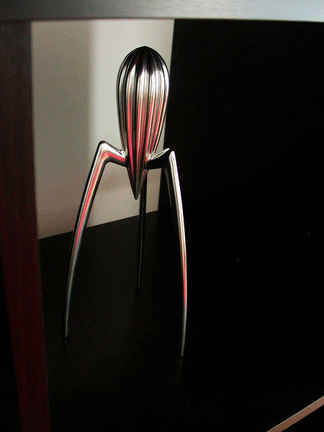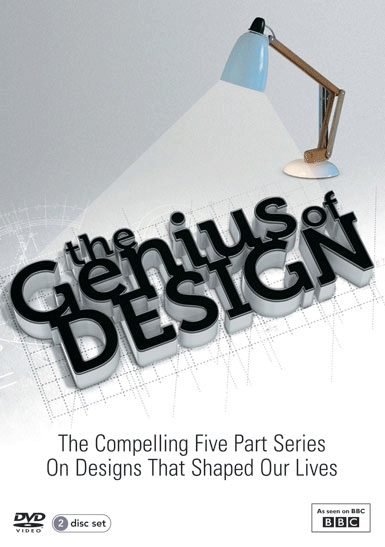
Over the weekend a friend of mine asked whether I had watched the ‘The Genius of Design’ programme that was broadcast on BBC on Friday night. She was disappointed to hear that I had missed it and proceeded to tell me how interesting it was especially the whole idea of ‘cradle to cradle design’. Although I had missed it (but have since watched it on BBC iPlayer) I was so pleased to hear someone who has never shown an inkling of interest in design before speak so rapturously about the subject. How great is it that this five part series has really opened up people’s eyes to design and not just design in general but product design.
Friday night’s episode was the last in a five part series that tells the story of design from the Industrial Revolution through 1920s modernism, the swinging 1960s, the designer 1980s and up to the present day. The final episode – entitled ‘Objects of Desire’ – explored the ‘designer decades’ of the 1980s and early 1990s. We started off in the Phillips de Pury Auction House in London where Marc Newson’s Lockheed Lounge, which he created in 1986, is sold for £950,000 making this probably the most desirable piece of furniture in the world.
The programme then features work by other designers who have shaped modern life including Ron Arad, Ettore Sotsass, Michael Graves and of course the design superstar himself Philippe Starck who in 1990 brought us a beautiful object for our kitchens that was by no means practical – the Juicy Salif lemon squeezer. Produced for Alessi and made from polished aluminium, it is considered an icon of industrial design and takes pride of place in many a kitchen, never to be used but only to be adored. As the narrator says, “For over 30 years Starck has been delighting an adoring audience who couldn’t care less about the old fashioned notion of form follows function.”

There is also a mention of IKEA who opened its first store in the UK in 1987. Love it or loath this Swedish furniture giant has certainly transformed the way we consume design. We have all done it – I even have a few IKEA pieces in my home and like the other 560 million IKEA customers worldwide, I am drawn by the fact that it’s cheap and the design is fairly inoffensive. The narrator explains, “During the 1980s design was something you paid extra for but IKEA proposed the opposite – you could charge less by building a whole process of industrial design around the economies that flat pack, self assembly furniture made possible.”
The programme then jumps to the other side of the pond to a coffee house in Silicon Valley where three old timers (two ex-Xerox and one ex-Apple) are talking about how during the 1970s they were designing the very first user interface for personal computers. They were the ones responsible for the democratising of computing and making digital technology available to the masses through the design of keyboards, the mouse and the ‘desktop’. As they are chattering away about all the ins and outs of the designs they created and how they come up with it and why, the camera pans out and the narrator says – what I believe must be the quote of the series – “These guys could go on all night. This is what designers do: obsess about the details so that you don’t have to.”
Of course, a programme on industrial design wouldn’t be complete without a few words from the man who brought us the iPod back in 2001 – Jonathan Ive. He reveals how clarity and simplicity are critically important to enable us to understand a product and enjoy using it.
So, with objects like the iPod and all the other thousands of shiny gadgets and consumer electronics that have hit the shelves in the past 10 years the programme then warns that the age of conspicuous consumption may have come to an end… or maybe not. Enter William McDonough – the founding principal of US design firm William McDonough + Partners as well as the author of the book ‘Cradle to Cradle Design: Remaking the Way we Make Things’. You then see him unscrew a Steelcase Think Chair – a chair that consists of up to 41% recycled materials and is 99% recyclable. All of its components and materials are designed to be infinitely re-used. As McDonough says: “I think with environmentalism a lot of people think we have to cut back. The exciting thing about cradle to cradle is that things are designed to either go back to soil safely or back to industry forever so we can celebrate consumption. Instead of it being something that destroys the world its something that enhances the world.”

So, ultimately the programme leaves us thinking that on the one hand we are getting sucked deeper into our personal electronic devices where we can’t wait for the launch of the next gadget. (I’m guilty as charged because with my 18 month phone contract almost up I can’t wait to get my hot little paws on Apple’s latest offering – the iPhone 4). But then, in the same breath I feel guilty because I know that landfills are bulging and raw materials are depleting and do I really need to have more stuff? But McDonough is giving us a get out clause because according to him, as long as its cradle to cradle design and the product can be recycled at end of its life, we can keep on shopping guilt-free.
Its certainly not as simple as that but this programme is definitely food for thought and left me wondering – where next for design? So, I urge all of you who haven’t caught the series to watch it again on BBC iPlayer otherwise you can buy the box set at the BBC Shop. Well worth the £15.99 and while you are at it, get your non designer friends to watch it too.






